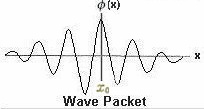

There's Something Hiding in the Dark
There something strange out there in the darkness -- a whole lot of it and it is a whole lot of strange. When astronomers first measured the speed of stars in our own galaxy and our nearby neighbors they knew something was off. The outer parts of galaxies rotated too fast compared to the visible stars and gas in galaxies. After years of examination and calculation they've determined there is five times more matter than what can be accounted for by stars and gas. Furthermore, the missing matter cannot be protons, neutrons, electrons, or neutrinos. And when the distant galaxies across the universe are examined they also have five times as much dark matter as normal matter.
 |
 |
Neutrinos are notoriously difficult to detect. They rarely interact with matter and light years thickness of lead would be required to stop all of them. As mentioned in my first post, "solid" material is mostly empty space. But even then I fudged a bit. It is a mistake to think of matter as being made of anything solid. Protons, neutrons, and electrons are not tiny billiard balls. Nor are the quarks that compose protons and neutrons. Instead they are really disturbances in space-time. Each of these sub-atomic particles have properties associated with them and when we talk about these properties we use the parlance of a billiard ball world, but it simply doesn't exist. Sub-atomic particles are said to have spin and we think of a tiny sphere spinning. And these particles have mass and we even talk about them having size. But none of these things are quite true.
 |
 |
|
| Probability density of an electron in a hydrogen atom |
Particles are wave packets. Their spin is a property associated with their wave functions. Their mass is an oscillating interaction with virtual particles that inhabit the background foam of space-time. Size really refers to the interaction radius. And the interaction radius depends on the type of interaction. Electrons interact with light, protons, and other electrons. These electromagnetic interactions have one interaction radius. Electrons also interact with neutrinos via the weak force. The electron size for those interactions is much smaller because the W and Z bozons that mediate that force are extremely short-lived. Neutrinos only interact via this weak force. And that is why they can pass through "solid" matter almost as if it weren't there.
Whatever particle makes up the dark matter which comprises more than 84% of the universe's matter, does not interact via the electromagnetic force. And it may not even interact via the weak force. It may only interact gravitationally. If that is the case, we may never observe them directly. It's not as if it is a billiard ball that will strike ordinary matter causing a recoil that we can observe, because there are no billiard balls -- at least not in the observable universe.
| Generation 1 | Generation 2 | Generation 3 | Force | |
|---|---|---|---|---|
| up quark | charm quark | top quark | 8 gluons strong force |
Higgs |
| down quark | strange quark | bottom quark | ||
| electron | muon | tauon | photon electromagnetic force |
|
| electron neutrino | muon neutrino | tau neutrino | W+, W-, Z, weak force |
|
| ? | ? | ? | graviton? gravity |
|
But consider the bizarre possibility that dark matter is actually made of billiard ball-like particles that actually do displace space in the same way that we intuitively think about protons and neutrons; that actually do have physical size and bounce off each other. They still wouldn't interact with the ephemeral, fuzzy wave-packet stuff that comprises our observable universe, (except to exert a weak gravitational force in aggregate). What if all we know and observe is but a shadow universe compared to dark matter.